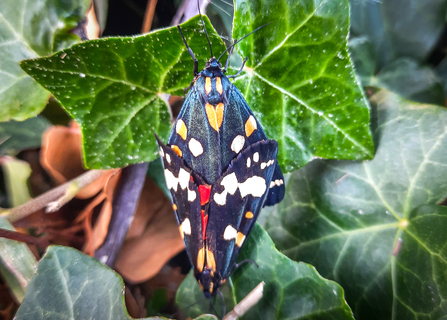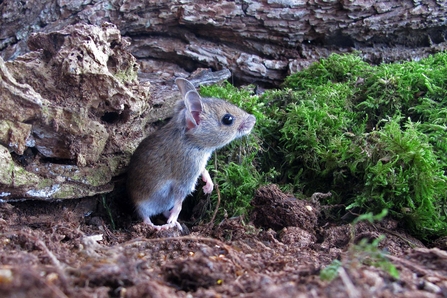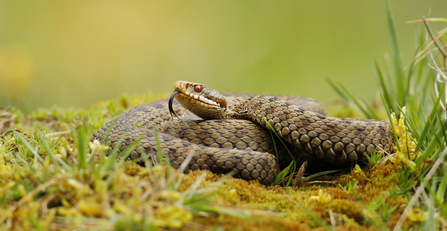
A mating pair of scarlet tiger moths. Picture: Pete Hughes
Adder basking on the mossy ground by Jon Hawkins

A mating pair of scarlet tiger moths. Picture: Pete Hughes
At the height of summer, love is in the air for hundreds of species - and none more so than the velvet-cloaked scarlet tiger moth.
These gloriously-coloured insects have dark, metallic black/green forewings with white adornments, but as soon as they take flight they flash their stunning red hindwings.
We have already seen dozens of these moths on the wing and forming mating pairs across Oxfordshire: look out for them in gardens, wetlands and near rivers - our Oxey Mead and Pixey Mead reserves in Oxford are great places start.

Wood mouse by Margaret Holland
Mice of all stripes are also in amorous mode at this time of year.
Wood mice start breeding in March and carry right through to the autumn, with females having numerous litters of four-to-seven babies – look out for them in woodlands like our Rushbeds Wood between Bicester and Aylesbury.
Harvest mice, meanwhile, which you can find at Chimney Meadows in West Oxfordshire, can get quite aggressive, and if a female gets fed up with a male chasing her she may turn around and given him a sharp nip!

Stoat kittens - or 'kits' - playing. Picture: Tom Hibbert
Stoats usually mate in August, but females don't give birth until the spring, so this is a good time of year to look out for their tiny kits.
After the young leave the den, the family usually stay together for some time, hunting and playing. The mother defends her family fiercely, so don't get in their way! Look out for stoat families in rural grassland, scrubby areas or woodlands.

Male smooth newt with mating crest. Picture: Niall Benvie/ 2020Vision
Newts have already mated for this year, and this year's young efts should now be visible in ponds. To begin with they look like tadpoles, with feathery gills and transparent body and tail, but as they grow their long, thin bodies make them easy to tell apart.
A great way to spend a sunny day in July is to sit by a pond like our CS Lewis reserve in Oxford looking out for young and adult newts.

Hop flowers growing in the sun. Picture: Jon Hawkins/ Surrey Hills Photography
Summer loving is, of course, not limited to the animal kingdom, and this is also a time of year when hundreds of plants come into flower.
One of the most magnificent is the humble hop - the flowers of which are used to make beer the world over.
These rambling, wild plants can be found all across our area - look out for their long vines scrabbling up other trees and bushes in roadside hedgerows - and if you've never smelt a fresh hop flower, treat yourself to the extraordinary fragrance which is a tiny explosion of pungent lemon and garlic.

Two male stag beetles fighting on a tree branch. Picture: Terry Whittaker/ 2020 Vision
One of the most extraordinary wild sights to catch at this time of year is stag beetles in flight.
These large, heavy insects - one of the UK's largest - almost look too big to fly when they're on the ground, and if a male - with its huge antlers - flies towards you out of the dusk on a summer's evening you certainly know about it!
We have more stag beetles in the east of our area - try looking for them in wooded areas at our Haymill Valley reserve near Slough or Chawridge Bank near Bracknell.

Adder basking on the mossy ground by Jon Hawkins
Another of the most striking wild sights of the summer in our area is the awesome adder.
These superb snakes, our only venomous species in the UK, are actually shy and retiring creatures, and you’ll be lucky to spot one.
Look out for them basking in quiet, sunny spots among the heather at our Greenham and Crookham Commons and Padworth Common reserves in Berkshire, and if you do see one just keep a respectful distance - they're much more scared of humans than we are of them!

Dartford Warbler perched on gorse by Richard Steel/2020VISION
While you're at Greenham Common, another wonderful species to look out for is the iconic Dartford warbler.
This small, slate and russet brown song bird, with its striking red eye depends on mature heathland habitat which we don't have a lot of in England: in the 1960s, there were only 10 pairs left in the UK. Today, there are about 3,200 pairs, and we are honoured to have them at Greenham. Look out for them warbling their rattly and scratchy song from the tops of a gorse bushes.

©Stefan Johansson
Swifts are another avian avatar of the season, bringing a little magic to our country as they spend the summer screaming around their nesting sites and patrolling our summer evenings in tight squadrons, before returning to Africa for the winter.
Swifts can be seen in quite a few places around our area, but they also need our help, and putting up a swift nest box is a great way to help. We have several boxes at our BBOWT office in Oxford and it's such a treat when they return each year.
How to tell the difference between swifts, swallows and martins

A chicken of the woods fungus (Laetiporus sulphureus) growing on the trunk of a tree. Picture: Vaughn Matthews
Our final wild highlight for July is not a bird at all, though it might sound like one – chicken of the woods.
This special species is actually a bright yellow bracket fungus that sprouts out the side of mature trees.
It gets its common name from the fact that some people say it has a similar texture to chicken when eaten: it doesn't agree with everyone so we don't recommend it, but there are numerous species which rely on it, including some specialist beetles which only feed on bracket fungi.
Look out for this sunny sentinel in mature deciduous woodlands like our Warburg Nature Reserve near Henley.
Sign up below to receive the latest news from BBOWT, tips about how you can help wildlife, plus information on how you can get involved.